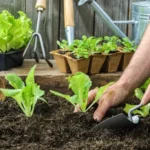Frost can catch you off guard and damage your garden overnight. When temperatures drop, delicate plants and vegetables become vulnerable to freezing, which can stunt growth or even kill them. Protecting your garden from frost is essential to keep your plants healthy and thriving through cold spells.
You don’t need to be an expert gardener to take simple steps that shield your garden from frost damage. With the right techniques and a little preparation, you can safeguard your plants and extend your growing season. Let’s explore practical ways you can protect your garden from frost and ensure your green space stays vibrant no matter the weather.
Understanding Frost and Its Impact on Gardens
Knowing frost’s nature and its effects on plants helps you protect your garden effectively. This section explains what frost is and how it affects your plants.
What Is Frost?
Frost forms when moisture in the air freezes on surfaces as temperatures fall below 32°F (0°C). It usually occurs during clear, calm nights when heat radiates away from the ground. Frost appears as tiny ice crystals on leaves, soil, and other garden surfaces. You can encounter two main types: hoar frost, which forms from water vapor freezing directly, and black frost, which happens when temperatures are low without visible ice formation.
How Frost Affects Plants
Frost damages plants by freezing the water inside cells, causing them to rupture. You might notice wilted, blackened, or brittle leaves shortly after a frost event. Tender plants, young shoots, and vegetables like tomatoes and lettuce suffer the most. Woody plants and established perennials resist frost better but still risk damage with prolonged exposure. Frost also slows photosynthesis and growth, weakening overall plant health. Recognizing these effects lets you take timely actions to minimize harm.
Preparing Your Garden for Frost Season
Preparing your garden before frost arrives reduces plant damage and extends your growing season. Focus on selecting hardy plants and scheduling planting times carefully.
Choosing Frost-Resistant Plants
Choose frost-resistant plants like kale, Brussels sprouts, and pansies to withstand temperatures below 32°F (0°C). Select native species adapted to your climate zone for improved survival chances. Include perennials such as sedum or thyme that tolerate mild frost without damage. Use seed catalogs or local extension services to identify plants rated for frost hardiness.
Timing Your Planting Schedule
Plant frost-sensitive vegetables, like tomatoes and peppers, after the last expected frost date to avoid early exposure. Sow cold-tolerant crops such as spinach and carrots at least 4-6 weeks before the first frost to allow growth before temperatures drop. Adjust planting schedules annually based on frost date predictions from NOAA or local meteorological sources to optimize growth and reduce frost risks.
Effective Methods to Protect Your Garden From Frost
Protecting your garden from frost involves practical techniques that reduce the impact of freezing temperatures on plants. Use these proven methods to shield your garden and maintain growth during frost-prone periods.
Using Mulch and Coverings
Apply 2 to 4 inches of organic mulch like straw, shredded leaves, or wood chips around plants to insulate soil and retain heat. Use plastic or fabric coverings over mulch to enhance protection; avoid direct contact with foliage to prevent freezing damage. Remove coverings during the day to allow sunlight and airflow.
Installing Frost Cloths and Blankets
Cover plants with frost cloths or garden blankets designed to trap heat while allowing moisture and light penetration. Secure edges with weights or stakes to prevent cold air from seeping under. Use lightweight materials for tender plants and heavier blankets for shrubs or young trees.
Utilizing Water and Irrigation Techniques
Water soil thoroughly before frost events; moist soil retains heat better than dry soil, providing thermal protection to roots. Use sprinklers to apply a fine mist during freezing conditions, as water releases heat when it freezes, creating a protective ice layer on foliage. Turn sprinklers off once temperatures rise above freezing to avoid waterlogging.
Creating Windbreaks and Shelter
Install windbreaks such as fences, hedges, or temporary screens to reduce cold wind exposure that accelerates frost damage. Position windbreaks upwind of sensitive plants and ensure they allow some airflow to prevent humidity buildup. Use cold frames or cloches for small plants to create localized frost-resistant environments.
Additional Tips and Tools for Frost Protection
Maximizing frost protection requires combining simple techniques with constant vigilance and smart garden design. These additional tips enhance your defenses against freezing temperatures.
Monitoring Weather Forecasts
Check local weather forecasts daily during frost-prone seasons to stay informed about temperature drops and frost warnings. Use reliable sources like the National Weather Service or weather apps with alert functions to receive real-time updates. Planning protective actions before frost events ensures your plants remain safe and minimizes last-minute risks.
Using Raised Beds and Containers
Use raised beds and containers to improve soil drainage and warmth retention, which reduces frost impact on roots. Raised beds warm faster in spring and cool more slowly at night compared to in-ground gardens, offering your plants extra protection. Containers can be moved indoors or sheltered during frost alerts, giving you flexible control over vulnerable plants. Choose materials like wood or plastic for insulation, and group containers to create microclimates that retain heat more effectively.
Conclusion
Protecting your garden from frost doesn’t have to be overwhelming. With the right approach and attention, you can keep your plants healthy and thriving even when temperatures dip. Staying proactive and using a combination of simple techniques helps you extend your growing season and enjoy a vibrant garden year-round. Remember, your garden’s resilience starts with your preparation.

Hi, I’m Md Rofiqul, a gardening enthusiast who loves spending time in the garden and backyard. I enjoy caring for plants, growing flowers and vegetables, and creating a green space that feels peaceful and refreshing. Gardening is more than just a hobby, it’s a passion that connects me to nature and brings joy to my daily life. Living with plants inspires me to embrace simplicity, patience, and sustainability while making every day more colorful and rewarding.

